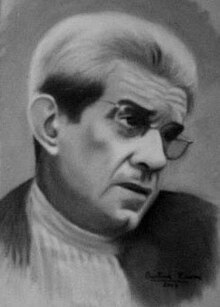
Jacques Marie Émile Lacan was a French psychoanalyst and psychiatrist. Described as "the most controversial psycho-analyst since Freud", Lacan gave yearly seminars in Paris from 1953 to 1981, and published papers that were later collected in the book Écrits. His work made a significant impact on continental philosophy and cultural theory in areas such as post-structuralism, critical theory, feminist theory and film theory, as well as on the practice of psychoanalysis itself.
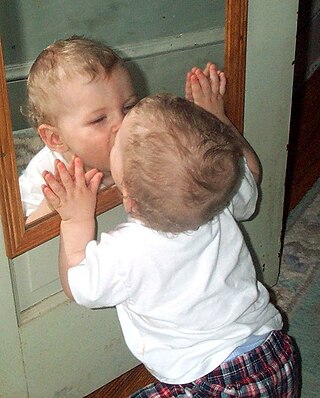
The mirror stage is a concept in the psychoanalytic theory of Jacques Lacan. The mirror stage is based on the belief that infants recognize themselves in a mirror (literal) or other symbolic contraption which induces apperception from the age of about six months.
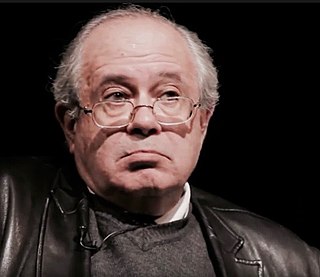
Jacques-Alain Miller is a psychoanalyst and writer. He is one of the founder members of the École de la Cause freudienne and the World Association of Psychoanalysis which he presided from 1992 to 2002. He is the sole editor of the books of The Seminars of Jacques Lacan.
The imaginary is the set of values, institutions, laws, and symbols through which people imagine their social whole. It is common to the members of a particular social group and the corresponding society. The concept of the imaginary has attracted attention in anthropology, sociology, psychoanalysis, philosophy, and media studies.
In the psychoanalytic theory of Jacques Lacan, objet petit a stands for the unattainable object of desire, the "a" being the small other ("autre"), a projection or reflection of the ego made to symbolise otherness, like a specular image, as opposed to the big Other which represents otherness itself. It is sometimes called the object cause of desire, as it is the force that induces desire towards any particular object. Lacan always insisted that the term should remain untranslated, "thus acquiring the status of an algebraic sign" (Écrits).
The objet petit a is what falls from the subject in anxiety.
Identification refers to the automatic, subconscious psychological process in which an individual becomes like or closely associates themselves with another person by adopting one or more of the others' perceived personality traits, physical attributes, or some other aspect of their identity. The concept of identification was founded by psychoanalyst Sigmund Freud in the 1920’s, and has since been expanded on and applied in psychology, social studies, media studies, and literary and film criticism. In literature, identification most often refers to the audience identifying with a fictional character, however it can also be employed as a narrative device whereby one character identifies with another character within the text itself.
In continental philosophy, the Real refers to the remainder of reality that cannot be expressed, and which surpasses reasoning. In Lacanianism, it is an "impossible" category because of its opposition to expression and inconceivability.
[T]he real in itself is meaningless: it has no truth for human existence. In Lacan's terms, it is speech that "introduces the dimension of truth into the real."
The Symbolic is the order in the unconscious that gives rise to subjectivity and bridges intersubjectivity between two subjects; an example is Jacques Lacan's idea of desire as the desire of the Other, maintained by the Symbolic's subjectification of the Other into speech. In the later psychoanalytic theory of Lacan, it is linked by the sinthome to the Imaginary and the Real.
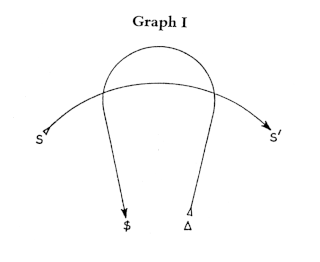
The graph of desire is a conceptual tool in Lacanianism.
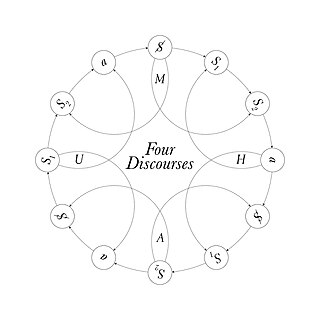
Four discourses is a concept developed by French psychoanalyst Jacques Lacan. He argued that there were four fundamental types of discourse. He defined four discourses, which he called Master, University, Hysteric and Analyst, and suggested that these relate dynamically to one another.
In the theory of Jacques Lacan, demand represents the way instinctive needs are inevitably alienated through the effects of language on the human condition. The concept of demand was developed by Lacan in parallel to those of need and desire to account for the role of speech on human aspirations. Demand forms part of Lacan's battle against the approach to language acquisition favored by ego psychology, and makes use of Kojeve's theory of desire. Demand is not a Freudian concept.
Sinthome is a concept introduced by Jacques Lacan in his seminar Le sinthome (1975–76). It redefines the psychoanalytic symptom in terms of the role of the subject outside of analysis, where enjoyment is made possible through creative identification with the symptom.
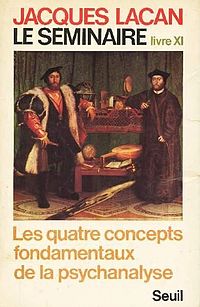
The Four Fundamental Concepts of Psychoanalysis is the 1978 English-language translation of a seminar held by Jacques Lacan. The original was published in Paris by Le Seuil in 1973. The Seminar was held at the École Normale Supérieure in Paris between January and June 1964 and is the eleventh in the series of The Seminar of Jacques Lacan. The text was published by Jacques-Alain Miller.
"The Instance of the Letter in the Unconscious, or Reason Since Freud" is an essay by the psychoanalyst Jacques Lacan, originally delivered as a talk on May 9, 1957 and later published in Lacan's 1966 book Écrits.
In Jacques Lacan's psychoanalytic philosophy, lack is a concept that is always related to desire. In his seminar Le transfert (1960–61) he states that lack is what causes desire to arise.
In psychoanalysis, foreclosure is a specific psychical cause for psychosis, according to French psychoanalyst Jacques Lacan.
The name of the father is a concept that Jacques Lacan developed from his seminar The Psychoses (1955–1956) to cover the role of the father in the Symbolic Order.
Serge Leclaire was a French psychiatrist and psychoanalyst. Initially analyzed by Jacques Lacan, he 'became the first French "Lacanian"'.
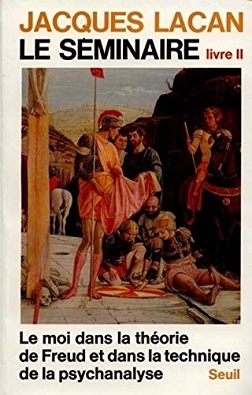
The Ego in Freud's Theory and in the Technique of Psychoanalysis is the 1988 English-language translation of published in Paris by Le Seuil in 1977. The text of the Seminar, which was held by Jacques Lacan at the Hospital of Sainte-Anne in Paris between the Fall of 1954 and the Spring of 1955 and is the second one in the series, was established by Jacques-Alain Miller and translated by Sylvana Tomaselli.
Lacanianism or Lacanian psychoanalysis is a theoretical system that explains the mind, behaviour, and culture through a structuralist and post-structuralist extension of classical psychoanalysis, initiated by the work of Jacques Lacan from the 1950s to the 1980s. Lacanian perspectives contend that the world of language, the Symbolic, structures the human mind, and stress the importance of desire, which is conceived of as endless and impossible to satisfy. Contemporary Lacanianism is characterised by a broad range of thought and extensive debate between Lacanians.
